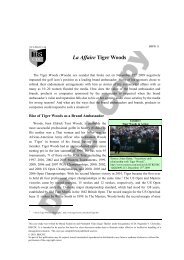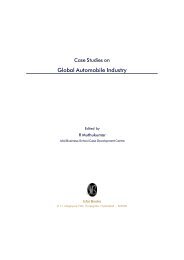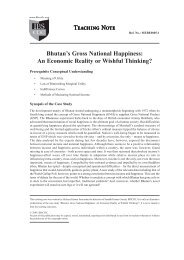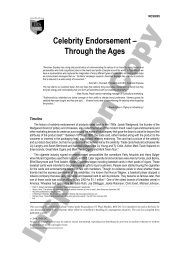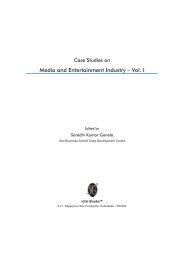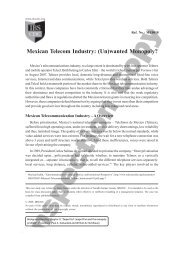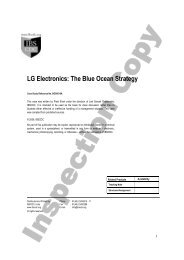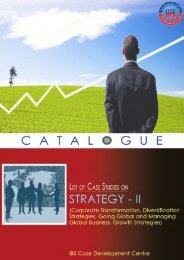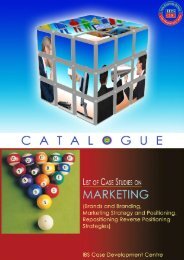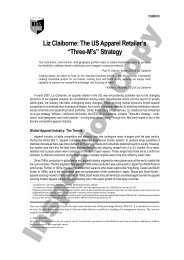Entrepreneurship Case Studies Catalogue
Entrepreneurship Case Studies Catalogue
Entrepreneurship Case Studies Catalogue
Create successful ePaper yourself
Turn your PDF publications into a flip-book with our unique Google optimized e-Paper software.
acquisitions, etc., reveals sharp business<br />
acumen. Mallya currently (2007) reigns<br />
over a diverse portfolio of businesses -<br />
alcoholic beverages, life sciences, aviation,<br />
agriculture, chemicals, and information<br />
technology. The incredible prices paid for<br />
his prime acquisitions are also debated. Do<br />
they reflect business insight or<br />
impulsiveness? Considering how Mallya<br />
built up the UB Empire it is pertinent to<br />
assess the long-term vision that drives the<br />
maverick entrepreneur.<br />
Pedagogical Objectives:<br />
• To comprehend the concepts of<br />
leadership<br />
• To analyse various leadership styles<br />
• To probe into Personality traits of a<br />
successful entrepreneur<br />
• To analyse whether Personality traits<br />
affect the business decisions of an<br />
entrepreneur.<br />
Industry Business Conglomerate<br />
Reference ENT0033C<br />
Year of Pub. 2008<br />
Teaching Available<br />
Struc.Assign. Available<br />
Keywords<br />
Vijay Mallya; Flamboyant style; Kingfisher;<br />
UB group; Liquor baron; Airlines;<br />
Mcdowells; <strong>Entrepreneurship</strong> <strong>Case</strong> Study;<br />
White & Mackay; Leadership; Beer<br />
market; Brand Extension; Entrepreneur;<br />
Personality traits; Alcoholic beverages<br />
Technology and Business<br />
Incubation in India-Challenges<br />
and Opportunities<br />
University of California, San Francisco<br />
(UCSF), in its 130-year-old history, had<br />
traditionally served as a regional medical<br />
institution for training competent doctors<br />
to serve western USA. For years UCSF was<br />
considered to be an unlikely place for<br />
radical inventions. The scenario started<br />
changing from 1968 when collaborative<br />
approach to fundamental research started<br />
attracting some of the brightest scientific<br />
minds to UCSF. UCSF gave the world two<br />
of its largest Biotech companies,<br />
"Genentech" and " Chiron". By 2003,<br />
UCSF became a world leader in biomedical<br />
research with an annual budget of $1.9<br />
billion besides being the largest employer<br />
in SanFrancisco.<br />
Pedagogical Objectives:<br />
• Concepts of TBI and its presence in<br />
India<br />
• Entrepreneurial challenges in India<br />
• Indian scenario in promoting new<br />
entrepreneurs through incubation<br />
• Incubator-incubatee relationship.<br />
Industry <strong>Entrepreneurship</strong> Training<br />
Reference ENT0032C<br />
Year of Pub. 2007<br />
Teaching Available<br />
Struc.Assign.<br />
Keywords<br />
Not Available<br />
<strong>Entrepreneurship</strong> <strong>Case</strong> Study; Technology<br />
and Business Incubation; Business<br />
Incubation; Incubator; Incubatee;<br />
<strong>Entrepreneurship</strong>; <strong>Entrepreneurship</strong> in<br />
India; Seed Capital; Gestation Period;<br />
Incubators in India; Innovation<br />
Management; Venture Capital; Technology<br />
transfer; Business strategies; Spin-offs;<br />
Business Plan<br />
The Body Shop (A): Anita<br />
Roddick’s Green Brand?<br />
The Body Shop was the leading ethical<br />
cosmetics retailer in the UK. In 1999, it<br />
was voted the second most trusted brand in<br />
the UK by the Consumers Association. In<br />
2004, it was selling ethically manufactured<br />
and sourced cosmetics, through 2000 stores<br />
across 50 countries with annual sales of<br />
£700 million.<br />
The Body Shop was founded by Anita<br />
Roddick (Anita) in 1976 with a single shop<br />
selling about 15 hand mixed products. She<br />
opened the first shop in Brighton, Sussex,<br />
as a means of supporting herself and her<br />
children. Anita’s deep passion for human<br />
rights and environmental issues affected<br />
the way she ran her company and sourced<br />
her products. Soon, over the next three<br />
decades, the Body Shop grew into a global<br />
network selling more than 500 products.<br />
Her company introduced the benefits of<br />
natural ingredients such as jojoba oil, aloe<br />
vera, rhassoul mud and cocoa butter, which<br />
were hitherto unheard of in the cosmetic<br />
world.<br />
But in the mid 1990s, the glory of the<br />
‘green’ brand faded with accusations about<br />
the Body Shop concept being stolen from<br />
the US, its product claims that it contained<br />
natural ingredients and problems with its<br />
franchises. By 2004, the Body Shop was<br />
facing declining sales in its home market.<br />
The brand was losing its luster in a market<br />
that was flooded with competitors offering<br />
similar products at a much lower cost. A<br />
majority of the Body Shop’s outlets were<br />
owned by franchisees which left the<br />
company dependent on their performance.<br />
Pedagogical Objectives<br />
• To discuss Anita Roddick’s<br />
entrepreneurial efforts<br />
• To discuss Anita’s strategy of promoting<br />
a brand on an ethical/corporate<br />
reputation strategy.<br />
Industry Personal Care Products<br />
Reference ENT0031C<br />
Year of Pub. 2006<br />
Teaching Note Available<br />
Struc.Assign. Not Available<br />
Keywords<br />
Natural Cosmetics; Ethical Marketing;<br />
Corporate Social Responsibility; Anita<br />
Roddick; The Body Shop; Personal care<br />
products; community trade; ethical<br />
cosmetic retailer; Beauty Care Market;<br />
human rights; environmental issues; animal<br />
testing; entrepreneurship; franchises.<br />
Nike’s Knight in Shining Armour<br />
Nike, one of the world’s largest sportswear<br />
manufacturers, had very humble<br />
beginnings. But propelled by the vision and<br />
energy of its founder, Philip Knight, the<br />
company attained iconic status among the<br />
global youth. With Knight finally retiring<br />
from the helm of Nike and the new CEO,<br />
William Perez, being perceived as an<br />
‘outsider’ to the industry, Nike faced a new<br />
twist in its history.<br />
This case highlights the entrepreneurial<br />
abilities of Philip Knight and talks of how<br />
he was responsible for creating one of the<br />
most well known businesses in the world.<br />
It can be used to discuss the potential fate<br />
of a company, till now driven by a single<br />
individual, suddenly handed over to a new<br />
leader.<br />
Pedagogical Objective<br />
• To understand the plight of a company<br />
driven by a new leader.<br />
Industry Footwear<br />
Reference No. ENT0030B<br />
Year of Pub. 2005<br />
Teaching Note Not Available<br />
Struc.Assig.<br />
keywords<br />
Not Available<br />
Nike; Phil Knight; Air Jordan; Nike's<br />
growth; Knight's leadership; Just do it;<br />
William Perez; Reuse-a-shoe; R & D at<br />
Nike; Nike Marketing; Wireless<br />
communication; Mobile messaging<br />
systems; Intellisync; Non-voice mobile<br />
services; SEVEN.<br />
Martha Stewart: The Rise of the<br />
Phoenix?<br />
The case is about Martha Stewart, the queen<br />
of home improvement in the US. The case<br />
highlights the emergence of Martha Stewart<br />
as an entrepreneur and the establishment<br />
of her company in the late 1990s. The<br />
case also outlines the decline of the ‘Martha<br />
Stewart’ brand and the subsequent fall in<br />
revenues of her company, Martha Stewart<br />
Living Omnimedia after she was indicted<br />
www.ibscdc.org<br />
ENTREPRENEURSHIP<br />
ENTREPRENEURSHIP<br />
3



